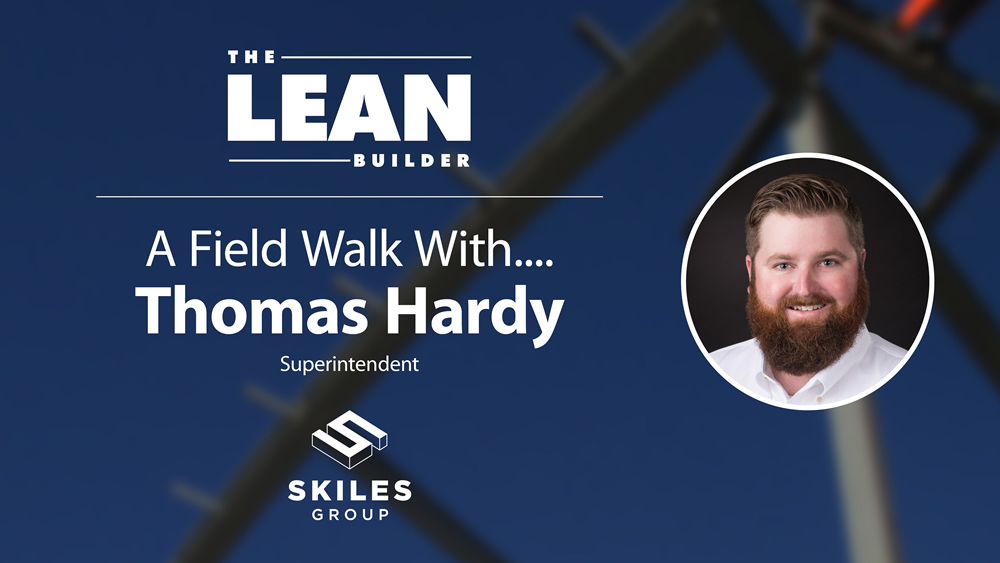This week on A Field Walk, we talk with Thomas Hardy, ICRA Certified, a superintendent with Skiles Group in Richardson, Texas.
“A Field Walk” is a Q&A-style series that features Lean practitioners sharing insights on their journey as well as advice on securing buy-in, tips for implementation, and more. As our community is built for shared learning, we trust you’ll find value from reading about their experience and examples.
A Field Walk with Thomas Hardy
Was there a specific reason or event that got you started on your Lean journey?
My Lean journey started when I met you (Keyan) for a lunch interview and heard you explain the Lean journey that Skiles Group has been working toward. This was not only a major turning point in my career, but it was also the beginning of my Lean journey. I had been using some Lean practices already in my career as a superintendent but was unaware of this broader and more encompassing revolution going on with Lean.
Why do you think many in our industry our resistant to Lean culture?
It’s common knowledge that people are afraid of change and the unknown. For someone who has been in the industry for a long time, it’s especially hard for them to get into the mindset of doing something different and outside the status quo of “this is how we’ve always done it.” With the younger generation coming up in the workforce though I’ve seen less resistance to Lean and change overall.
Do you think Lean can be practiced on projects without the major trades and/or GC buy-in?
YES. For Lean to work it doesn’t have to be site-wide, it can be just one of the trades engaged with Lean to make an impact on the job. When I’ve encountered resistance on the job site and don’t have buy-in from one trade or multiple trades, I just stay constant with Lean and implement those areas of my control in a Lean way. Eventually, those trades see the impact Lean can have and begin to come on board.
How do you convince trade partners or other superintendents who are resistant to change to try something new?
Be consistent. I’ve found that if I stay constant in my everyday Lean Journey and don’t change what I am doing in terms of my process, approach, and work, they either join with me (most of the time) or keep doing what they have always done. Not everyone is going to like it and want to change (and that’s okay); I’m not here to force everyone to change their minds or dictate behavior. Now, if they are toxic to the team and working against us, I will try and get someone else from their company onsite.
What Lean process, tool, or methodology has been a game changer to the way you run work in the field?
Daily huddles. This has been the game changer when it comes to showing more people the power of Lean and how it works. And, as I’ve said, consistency is the number one factor. Having your daily huddles at the SAME TIME EVERY DAY is what brings everyone to the table and what enables trades to start holding others accountable. I know that I have full buy-in on a project when all the trade partners arrive at the huddle before I do.
For superintendents or trade partners that are new to Lean, where should they start?
I would tell them to start small and take “baby steps” into what they think will be most beneficial for their project. For many beginners, the daily huddle is an easy first step. The Lean journey is not supposed to be overwhelming and cumbersome; it’s supposed to make our lives easier and better.
What is the single most important value achieved from Lean?
Respect for people. This is a huge factor in the work environment and culture that we’re trying to create. At the end of the day, and the end of the project, you want every person who has been on the job site to feel respected and valued. It takes everyone involved to make these projects happen.
Do you think Lean should/can be practiced on all/most projects, if not what percent do you think it can be effective?
Lean can be practiced on all projects. Lean is not just about using visual communication tools, a 6-week look ahead, and daily huddles. Lean can go deeper with how we treat others on the job site. If you don’t have an office on the job site or your trades are only on-site for a few days at a time, you as the superintendent need to ensure that those on-site daily have proper gathering places for meetings, have some seating and shade for meals, and have clean restroom facilities. YOU as a superintendent set the tone and can treat everyone with respect – that’s part of the Lean Journey.
Where do you see the future of our business heading in terms of how projects are led in the field?
I see a more collaborative, respected, and less stressful future. It’s a must have. Our industry leads in suicide and alcoholism rates for our workers. Almost every seasoned superintendent I’ve met has either been divorced serval times or has had a major heart attack. I would like to make construction fun again for our current trade professionals and future generations in our industry.









